Collective Molecular Activities of the Plant: Petalostemon Gattingeri
Plant ID: NPO22716
Plant Latin Name: Petalostemon Gattingeri
Taxonomy Genus: Petalostemon
Taxonomy Family: Fabaceae
Plant External Links:
NCBI TaxonomyDB:
n.a.
Plant-of-the-World-Online:
n.a.
Overview of Ingredients
26 All known Ingredients in Total
Unique ingredients have been isolated from this plant.Plant-Ingredients Associations were manually curated from publications or collected from other databases.
13 Ingredients with Acceptable Bioavailablity
Unique ingredients exhibit acceptable human oral bioavailablity, according to the criteria of SwissADME [PMID: 28256516] and HobPre [PMID: 34991690]. The criteria details:SwissADME: six descriptors are used by SwissADME to evaluate the oral bioavailability of a natural product:
☑ LIPO(Lipophility): -0.7 < XLOGP3 < +5.0
☑ SIZE: 150g/mol < MW < 500g/mol
☑ POLAR(Polarity): 20Ų < TPSA < 130Ų
☑ INSOLU(Insolubility): -6 < Log S (ESOL) < 0
☑ INSATU(Insaturation): 0.25 < Fraction Csp3 < 1
☑ FLEX(Flexibility): 0 < Num. rotatable bonds < 9
If 6 descriptors of a natural plant satisfy the above rules, it will be labeled high HOB.
HobPre: A natural plant ingredient with HobPre score >0.5 is labeled high human oral availability (HOB)
8 Ingredients with experimental-derived Activity
Unique ingredients have activity data available.Ingredient Structrual Cards
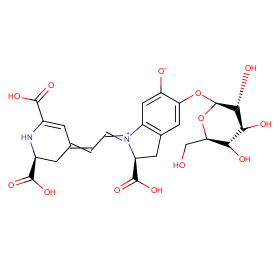
Ingredient ID: NPC90672
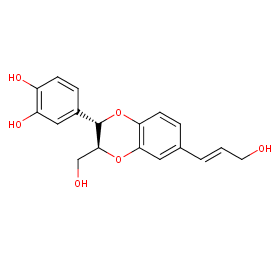
Ingredient ID: NPC79253
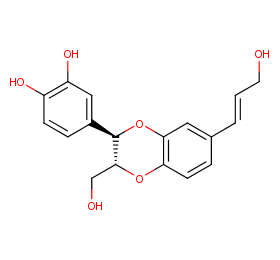
Ingredient ID: NPC72529

Ingredient ID: NPC70718
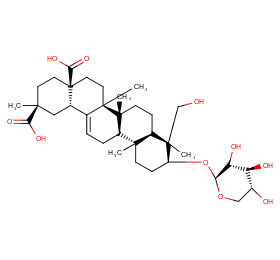
Ingredient ID: NPC65766

Ingredient ID: NPC63227
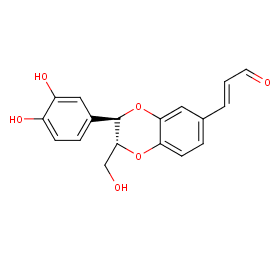
Ingredient ID: NPC59844
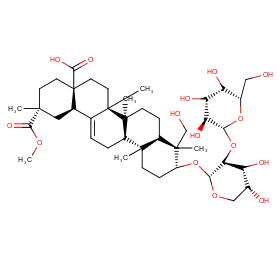
Ingredient ID: NPC32364
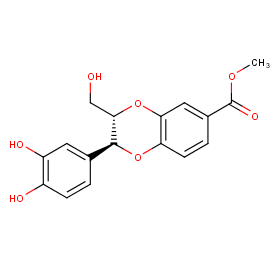
Ingredient ID: NPC289315
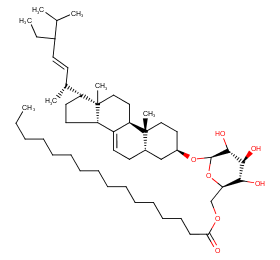
Ingredient ID: NPC263441
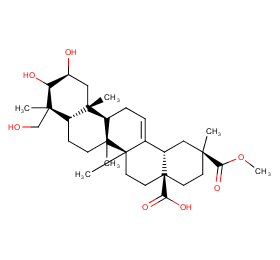
Ingredient ID: NPC249352
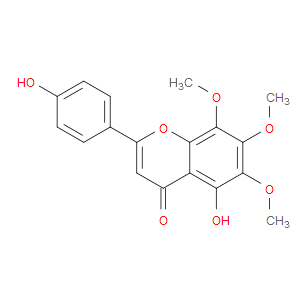
Ingredient ID: NPC231018

Ingredient ID: NPC220786
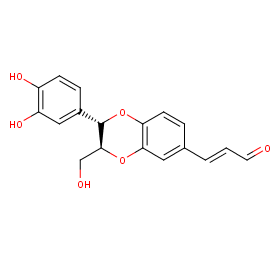
Ingredient ID: NPC214729
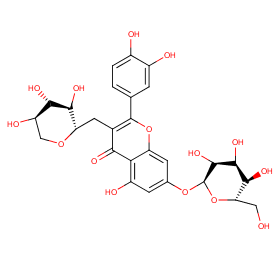
Ingredient ID: NPC208592

Ingredient ID: NPC199537

Ingredient ID: NPC195848
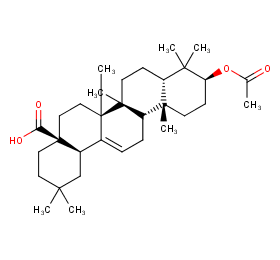
Ingredient ID: NPC192582
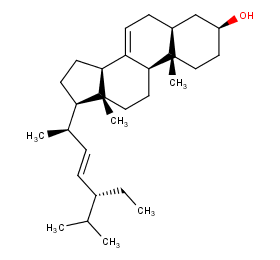
Ingredient ID: NPC192040

Ingredient ID: NPC174265

Ingredient ID: NPC154078

Ingredient ID: NPC150822
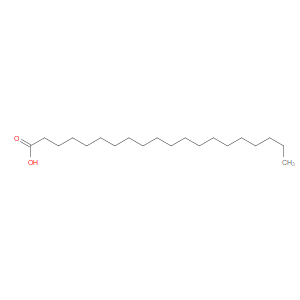
Ingredient ID: NPC149184
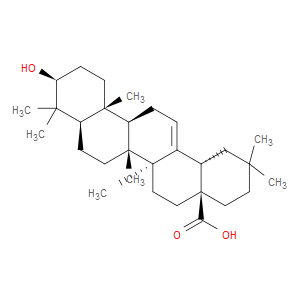
Ingredient ID: NPC142415

Ingredient ID: NPC140291
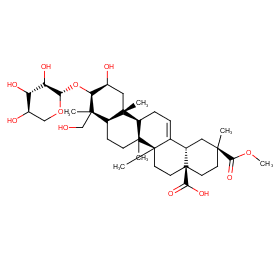
Ingredient ID: NPC127853
Classification of Human Proteins Collectively Targeted by the Plant
Detailed Information of Target Proteins
| Target Type | Protein Class | Gene ID | Protein Name | Uniprot ID | Target ChEMBL ID |
|---|---|---|---|---|---|
| Therapeutic Target | Enzyme | CES1 | Acyl coenzyme A:cholesterol acyltransferase | P23141 | CHEMBL2265 |
| Therapeutic Target | Nuclear hormone receptor subfamily 1 | NR1H4 | Bile acid receptor FXR | Q96RI1 | CHEMBL2047 |
| Therapeutic Target | Protein Phosphatase | CDC25B | Dual specificity phosphatase Cdc25B | P30305 | CHEMBL4804 |
| Therapeutic Target | Surface antigen | F3 | Coagulation factor III | P13726 | CHEMBL4081 |
❱❱❱ Associated Human Diseases and Detailed Association Evidence
How do we define the Plant-Targeted Human Disease Association?
Associated human diseases of an individual plant are summurized based on FOUR types of association evidence, these include:
❶ Association by Therapeutic Target: Bioactive protein targets of the plant were defined in "Molecular Targets" section, target-disease associations collected from TTD database were subsequently used to build the associations between the plant and its targeted human diseases.
❷ Association by Disease Gene Reversion: Plant and a specific disease will be associated when >= 1 plant target gene overlaped with disease's DEGs.
❸ Association by Clinical Trials of Plant: Plant and a specific disease will be associated when >= 1 clinical trial (the plant is the intervetion) can be matched in ClinicalTrials.gov database.
❹ Association by Clinical Trials of Plant Ingredients: Plant and a specific disease will be associated when >= 1 clinical trial (the plant ingredient is the intervetion) can be matched in ClinicalTrials.gov database.
Associated Disease of the Plant | Association Type & Detailed Evidence |
|---|---|
Acute diabete complicationDisease Category: 05.Endocrine, nutritional or metabolic diseasesDisease ICD-11 Code: 5A2Y |
PTPN1
|
Acute myeloid leukaemiaDisease Category: 02.NeoplasmsDisease ICD-11 Code: 2A60 |
PTPRC
|
Acute respiratory distress syndromeDisease Category: 12.Diseases of the respiratory systemDisease ICD-11 Code: CB00 |
F3
|
Adenocarcinoma of bronchus or lungDisease Category: 02.NeoplasmsDisease ICD-11 Code: 2C25.0 |
AKR1B10
|
Adenocarcinoma of pancreasDisease Category: 02.NeoplasmsDisease ICD-11 Code: 2C10.0 |
AKR1B10,PTPRC,PTPN1,CDC25B,CES1
|
Adenocarcinoma of stomachDisease Category: 02.NeoplasmsDisease ICD-11 Code: 2B72.0 |
CDC25B
|
BCR-ABL1-negative chronic myeloid leukaemiaDisease Category: 02.NeoplasmsDisease ICD-11 Code: 2A41 |
PTPRC
|
Bleeding disorderDisease Category: 16.Diseases of the genitourinary systemDisease ICD-11 Code: GA20-GA21 |
F3
|
Breast cancerDisease Category: 02.NeoplasmsDisease ICD-11 Code: 2C60-2C6Y |
PTPN1
|
Carcinosarcoma of uterusDisease Category: 02.NeoplasmsDisease ICD-11 Code: 2C76.43 |
AKR1B10
|

